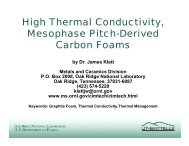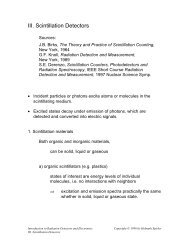Introduction to radiation-resistant semiconductor devices and circuits
Introduction to radiation-resistant semiconductor devices and circuits
Introduction to radiation-resistant semiconductor devices and circuits
You also want an ePaper? Increase the reach of your titles
YUMPU automatically turns print PDFs into web optimized ePapers that Google loves.
Typical parameter sets are k0 = (0.85+25-0.82) cm 3 /s <strong>and</strong> Ea= 1.16±0.08 eV (16),<br />
<strong>and</strong> k0 = (520+1590-392) cm 3 /s <strong>and</strong> Ea= 1.31±0.04 eV (9).<br />
Anti-annealing is a concern because of its effect on detec<strong>to</strong>r depletion voltage,<br />
i.e. the voltage required <strong>to</strong> collect mobile charge from the complete thickness of<br />
the silicon detec<strong>to</strong>r. Since this voltage increases with space-charge concentration,<br />
antiannealing can easily exceed the safe operating range, especially at high<br />
fluences. The relative effect of anti-annealing increases strongly with fluence <strong>and</strong><br />
temperature, as illustrated in Table 2, which shows the relative increase in doping<br />
<strong>and</strong> required operating voltage. Clearly, low temperature operation is beneficial.<br />
Nevertheless, even a low temperature system will require maintenance at room<br />
temperature <strong>and</strong> warm up periods must be controlled very carefully. (9,16)<br />
Fluence [cm -2 ]<br />
10 13<br />
10 14<br />
Na (t=100h)/Na(t=0) = V (t=100h)/V (t=0)<br />
0 °C 20 °C 40 °C<br />
1.00 1.02 1.39<br />
1.01 1.21 4.71<br />
TABLE 2. Relative antiannealing after 100 h vs. fluence <strong>and</strong> temperature<br />
Data on charge collection efficiency are still rather sketchy. The primary<br />
mechanism is expected <strong>to</strong> be trapping of signal charge at defect sites, i.e. a<br />
decrease in carrier lifetime τ. Since the loss in signal charge is proportional <strong>to</strong><br />
exp(-tc /τ ), reducing the collection time mitigates the effect. Since either the<br />
operating voltage is increased or depletion widths are reduced at damage levels<br />
where charge trapping is appreciable, fields tend <strong>to</strong> be higher <strong>and</strong> collection times<br />
decrease au<strong>to</strong>matically with <strong>radiation</strong> damage, provided the detec<strong>to</strong>r can sustain<br />
the higher fields.<br />
Typical measurements have determined the signal charge vs. bias voltage <strong>and</strong><br />
have taken the plateau value (or the maximum signal charge just below breakdown).<br />
Lemeilleur et al. (18) find ΔQ/Q0 = γΦ, where γ = (0.024±0.004)⋅10 -13 cm 2<br />
for 1 MeV equivalent neutrons. Fretwurst et al. (19) find similar results, with a<br />
dependence 1/τ = γΦ, where for holes γp= 2.7⋅10 -7 cm 2 s <strong>and</strong> for electrons<br />
γe= 1.2⋅10 -6 cm 2 s for Φ>10 13 cm -2 of 1 MeV equivalent neutrons. For a fluence<br />
Φ= 5⋅10 13 cm -2 s -1 , a 400 μm thick detec<strong>to</strong>r with a depletion voltage of 130V<br />
operated at a bias voltage of 200V would show a decrease in signal charge of<br />
12%. Ohsugi et al. (20) have demonstrated the operation of strip detec<strong>to</strong>rs <strong>to</strong><br />
neutron fluences beyond 10 14 cm -2 , with signal losses of about 10%. Similar results<br />
11





